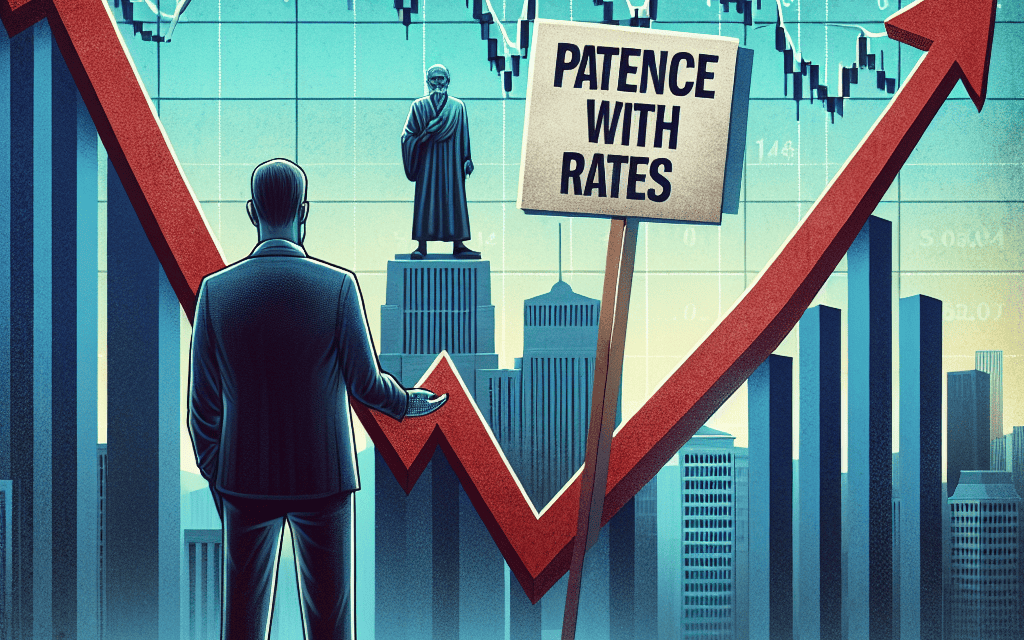“Market Dips as Powell Holds Firm: Patience Over Panic in Interest Rate Strategy”
Introduction
In recent developments, the stock market has experienced notable declines following Federal Reserve Chair Jerome Powell’s indication that there is no immediate plan to lower interest rates. This announcement has sent ripples through financial markets, as investors recalibrate their expectations in light of the Fed’s cautious stance on monetary policy. Powell’s remarks underscore the central bank’s commitment to maintaining higher interest rates to combat inflation, despite growing concerns about economic growth and market stability. As a result, market participants are grappling with the implications of prolonged elevated borrowing costs, which have the potential to impact corporate earnings, consumer spending, and overall economic momentum. This period of uncertainty highlights the delicate balance the Federal Reserve must strike between curbing inflation and supporting economic recovery, leaving investors to navigate a complex and evolving financial landscape.
Impact Of Interest Rate Decisions On Stock Market Trends
The stock market often reacts sensitively to signals from the Federal Reserve, and recent comments from Chairman Jerome Powell have underscored this dynamic. As Powell indicated that there is no immediate rush to lower interest rates, investors have responded with caution, leading to noticeable declines in stock market indices. This development highlights the intricate relationship between interest rate decisions and stock market trends, a connection that is pivotal for investors to understand.
Interest rates, set by the Federal Reserve, serve as a critical tool for managing economic growth and inflation. When the Fed raises interest rates, borrowing costs increase, which can slow down consumer spending and business investment. Conversely, lowering interest rates tends to stimulate economic activity by making borrowing cheaper. Therefore, the Fed’s interest rate policies are closely monitored by investors, as they can significantly influence market conditions.
Powell’s recent remarks suggest that the Federal Reserve is prioritizing its fight against inflation over immediate economic stimulation. By signaling that interest rates will remain elevated for the foreseeable future, Powell has effectively communicated that the Fed is committed to ensuring that inflation does not spiral out of control. This stance, while prudent from a macroeconomic perspective, has implications for the stock market. Higher interest rates can lead to increased costs for companies, particularly those that rely heavily on borrowing. This, in turn, can compress profit margins and lead to lower stock valuations.
Moreover, the prospect of sustained high interest rates can also affect investor sentiment. When interest rates are high, fixed-income investments such as bonds become more attractive relative to stocks, as they offer better returns with lower risk. This shift in investor preference can lead to a reallocation of assets, with more capital flowing out of equities and into bonds. Consequently, stock prices may decline as demand for equities diminishes.
In addition to these direct effects, Powell’s comments have broader implications for market volatility. The uncertainty surrounding future interest rate movements can lead to increased market fluctuations, as investors attempt to anticipate the Fed’s next steps. This environment of uncertainty can exacerbate market declines, as investors may become more risk-averse and opt to sell off stocks in favor of safer investments.
Despite these challenges, it is important to recognize that the stock market’s reaction to interest rate signals is not always straightforward. While higher interest rates can pose headwinds for equities, they can also reflect a robust economic backdrop. If the economy is strong enough to withstand higher borrowing costs, this can be a positive indicator for long-term growth prospects. Therefore, investors must carefully weigh the implications of interest rate decisions within the broader economic context.
In conclusion, Jerome Powell’s indication that there is no rush to lower interest rates has had a palpable impact on stock market trends, underscoring the significant influence of Federal Reserve policies on investor behavior. As the market navigates this period of uncertainty, understanding the interplay between interest rates and stock valuations remains crucial for investors seeking to make informed decisions. While the immediate reaction may be one of caution, the long-term effects will depend on how the economy adapts to the Fed’s monetary policy stance.
Analyzing Powell’s Statements: What It Means For Investors
Federal Reserve Chair Jerome Powell’s recent statements have sent ripples through the stock market, as investors grapple with the implications of a prolonged period of elevated interest rates. Powell’s indication that there is no immediate rush to lower interest rates has prompted a reassessment of market strategies, as stakeholders seek to understand the broader economic context and its potential impact on their portfolios. This development underscores the intricate relationship between monetary policy and market dynamics, highlighting the need for investors to remain vigilant and adaptable.
Powell’s remarks come at a time when inflationary pressures continue to pose challenges to economic stability. By signaling a cautious approach to interest rate adjustments, the Federal Reserve aims to ensure that inflation is kept in check, thereby safeguarding long-term economic growth. However, this stance has also led to concerns about the potential dampening effect on economic activity, as higher borrowing costs could curb consumer spending and business investments. Consequently, investors are now tasked with navigating a complex landscape where the balance between inflation control and economic momentum is delicately poised.
In light of Powell’s statements, market participants are reevaluating their investment strategies, with a particular focus on sectors that are sensitive to interest rate fluctuations. For instance, the technology sector, which has been a significant driver of market gains in recent years, may face headwinds as higher interest rates increase the cost of capital and potentially slow down innovation and expansion efforts. Similarly, the real estate market, which is heavily reliant on borrowing, could experience a slowdown as mortgage rates rise, affecting both residential and commercial property investments.
Moreover, Powell’s indication of a steady interest rate environment has implications for fixed-income investments. Bonds, traditionally seen as a safe haven during periods of market volatility, may offer more attractive yields in a high-interest-rate environment. This could lead to a shift in investor preferences, as some may opt to rebalance their portfolios in favor of fixed-income securities, seeking stability and predictable returns amidst the uncertainty.
Transitioning to the broader economic implications, Powell’s stance reflects a commitment to maintaining financial stability while addressing inflationary concerns. This approach is crucial in preventing the economy from overheating, which could lead to more severe corrective measures in the future. However, it also necessitates a careful consideration of the potential trade-offs, as prolonged high interest rates could stifle economic growth and exacerbate income inequality.
For investors, the key takeaway from Powell’s statements is the importance of diversification and risk management. In an environment where interest rates remain elevated, a diversified portfolio that includes a mix of asset classes can help mitigate risks and enhance resilience. Additionally, investors should remain informed about macroeconomic trends and central bank policies, as these factors will continue to play a pivotal role in shaping market conditions.
In conclusion, Jerome Powell’s recent comments on interest rates have prompted a reevaluation of market strategies, as investors seek to navigate the challenges posed by a high-interest-rate environment. By understanding the implications of monetary policy decisions and their impact on various sectors, investors can make informed choices that align with their financial goals. As the economic landscape continues to evolve, staying adaptable and informed will be essential for successfully managing investments in the face of uncertainty.
Historical Context: Stock Market Reactions To Interest Rate Policies
The relationship between stock market performance and interest rate policies has long been a subject of keen interest among investors, economists, and policymakers. Historically, the stock market has exhibited sensitivity to changes in interest rates, often reacting to signals from central banks regarding future monetary policy. This dynamic was once again evident when Federal Reserve Chair Jerome Powell recently indicated that there would be no immediate rush to lower interest rates, leading to a noticeable decline in stock market indices. To understand this reaction, it is essential to explore the historical context of how stock markets have responded to interest rate policies over the years.
In the past, the stock market has often thrived in environments where interest rates were low, as such conditions typically encourage borrowing and investment. Low interest rates reduce the cost of capital for businesses, enabling them to expand operations, invest in new projects, and ultimately drive economic growth. Consequently, investors tend to favor equities during periods of low interest rates, anticipating higher corporate earnings and increased stock valuations. However, when central banks signal a shift towards higher interest rates, the stock market often reacts with caution, as higher borrowing costs can dampen economic activity and corporate profitability.
The 1990s provide a notable example of this phenomenon. During this decade, the Federal Reserve, under the leadership of Alan Greenspan, maintained relatively low interest rates, contributing to a prolonged bull market. The technology boom further fueled investor optimism, leading to significant gains in stock prices. However, as the decade drew to a close, concerns about inflation prompted the Fed to raise interest rates, resulting in increased market volatility and the eventual bursting of the dot-com bubble.
Similarly, the early 2000s witnessed a period of low interest rates following the 2001 recession, which helped to stimulate economic recovery and support the housing market. However, as the economy strengthened, the Federal Reserve gradually increased rates, culminating in the financial crisis of 2008. The crisis underscored the delicate balance central banks must maintain between fostering economic growth and preventing asset bubbles.
In more recent years, the stock market has continued to respond to interest rate signals with heightened sensitivity. The aftermath of the 2008 financial crisis saw central banks around the world adopt unprecedented monetary easing measures, including near-zero interest rates and quantitative easing programs. These policies were instrumental in stabilizing financial markets and supporting economic recovery. However, as economies regained strength, central banks faced the challenge of normalizing monetary policy without disrupting market stability.
The current scenario, where Powell has signaled no rush to lower interest rates, reflects a cautious approach by the Federal Reserve in navigating the post-pandemic economic landscape. While the decision aims to curb inflationary pressures and ensure sustainable growth, it also highlights the complexities of managing market expectations. Investors, accustomed to a prolonged period of low rates, may need to adjust their strategies in response to a potentially higher interest rate environment.
In conclusion, the historical context of stock market reactions to interest rate policies reveals a consistent pattern of sensitivity and adjustment. As central banks continue to play a pivotal role in shaping economic conditions, understanding this interplay remains crucial for investors seeking to navigate the complexities of financial markets. The recent decline in stock markets following Powell’s remarks serves as a reminder of the intricate relationship between monetary policy and market dynamics, underscoring the importance of vigilance and adaptability in investment decision-making.
Strategies For Investors During Periods Of Market Decline

In the wake of Federal Reserve Chair Jerome Powell’s recent remarks indicating a cautious approach to lowering interest rates, the stock market has experienced notable declines. This development has left many investors pondering the best strategies to navigate such turbulent times. While market downturns can be unsettling, they also present opportunities for those who approach them with a well-considered plan. Understanding the dynamics at play and adopting appropriate strategies can help investors mitigate risks and potentially capitalize on market fluctuations.
Firstly, it is crucial for investors to maintain a long-term perspective. Market declines, while often alarming, are a natural part of the economic cycle. Historical data suggests that markets tend to recover over time, rewarding those who remain patient and committed to their investment goals. By focusing on long-term objectives rather than short-term volatility, investors can avoid making impulsive decisions that may undermine their financial plans.
Moreover, diversification remains a cornerstone of effective investment strategy, particularly during periods of market decline. By spreading investments across various asset classes, sectors, and geographic regions, investors can reduce the impact of a downturn in any single area. This approach not only helps in managing risk but also positions investors to benefit from potential recoveries in different segments of the market. For instance, while equities may be under pressure, bonds or commodities might offer more stability or even growth opportunities.
In addition to diversification, maintaining a disciplined approach to asset allocation is essential. Regularly reviewing and rebalancing one’s portfolio ensures that it remains aligned with the investor’s risk tolerance and financial goals. During market declines, certain asset classes may become undervalued, presenting opportunities to buy at lower prices. Conversely, other assets may have appreciated, necessitating a strategic reallocation to maintain the desired balance.
Furthermore, investors should consider the role of cash in their portfolios. While holding cash may seem counterintuitive during a market decline, it provides liquidity and flexibility to seize opportunities as they arise. Having cash on hand allows investors to purchase quality assets at discounted prices, potentially enhancing long-term returns. Additionally, cash reserves can serve as a buffer against further market volatility, providing peace of mind in uncertain times.
Another strategy worth considering is dollar-cost averaging, which involves investing a fixed amount of money at regular intervals, regardless of market conditions. This approach can help mitigate the impact of market volatility by spreading out investments over time, reducing the risk of making large investments at inopportune moments. By consistently investing, investors can take advantage of lower prices during market declines and benefit from potential gains when the market rebounds.
Lastly, staying informed and seeking professional advice can be invaluable during periods of market decline. Keeping abreast of economic developments, market trends, and policy changes can help investors make informed decisions. Consulting with financial advisors or investment professionals can provide additional insights and guidance tailored to individual circumstances, ensuring that strategies are aligned with personal financial goals and risk tolerance.
In conclusion, while market declines can be challenging, they also offer opportunities for those who approach them with a strategic mindset. By maintaining a long-term perspective, diversifying investments, adhering to disciplined asset allocation, holding cash reserves, employing dollar-cost averaging, and seeking professional advice, investors can navigate periods of market decline with confidence and poise.
The Role Of Central Banks In Shaping Market Sentiment
The role of central banks in shaping market sentiment is a critical aspect of global financial dynamics, and recent developments have underscored this influence. The stock market experienced notable declines following Federal Reserve Chair Jerome Powell’s indication that there is no immediate rush to lower interest rates. This announcement has reverberated through financial markets, highlighting the profound impact central bank policies have on investor behavior and market trends.
Central banks, particularly the Federal Reserve in the United States, wield significant power in influencing economic conditions through their monetary policy decisions. By adjusting interest rates, they can either stimulate economic activity or cool down an overheating economy. In recent years, the Fed has maintained a relatively accommodative stance, keeping interest rates low to support recovery from economic disruptions. However, as inflationary pressures have mounted, the central bank has shifted its focus towards tightening monetary policy to prevent the economy from overheating.
Powell’s recent remarks suggest a cautious approach to altering the current interest rate trajectory. While some market participants had hoped for a more dovish stance, indicating potential rate cuts in the near future, Powell’s comments have tempered these expectations. This has led to a recalibration of market sentiment, as investors reassess their strategies in light of a potentially prolonged period of higher interest rates.
The stock market’s reaction to Powell’s statements underscores the sensitivity of financial markets to central bank communications. When central banks signal a shift in policy direction, it can lead to significant volatility as investors adjust their portfolios to align with the anticipated economic environment. In this instance, the prospect of sustained higher interest rates has prompted concerns about the cost of borrowing and its potential impact on corporate profits and consumer spending.
Moreover, the influence of central banks extends beyond immediate market reactions. Their policy decisions can shape broader economic trends, affecting everything from employment rates to inflation expectations. As such, central banks must carefully balance their objectives, ensuring that their actions support economic stability without inadvertently stifling growth.
In addition to domestic considerations, central banks must also navigate the complexities of the global economy. In an interconnected world, policy decisions made by one central bank can have ripple effects across international markets. For instance, the Federal Reserve’s stance on interest rates can influence capital flows, exchange rates, and economic conditions in other countries. This interconnectedness necessitates a nuanced approach to policy-making, as central banks strive to achieve their domestic mandates while considering global implications.
In conclusion, the recent stock market declines following Powell’s indication of no rush to lower interest rates highlight the pivotal role central banks play in shaping market sentiment. Their policy decisions have far-reaching consequences, influencing not only immediate market reactions but also broader economic trends. As investors and policymakers alike navigate this complex landscape, the importance of clear and effective communication from central banks cannot be overstated. By providing guidance on their policy intentions, central banks can help mitigate uncertainty and foster a more stable economic environment, ultimately supporting sustainable growth and prosperity.
Long-term Vs. Short-term Investment Approaches In Volatile Markets
In the wake of Federal Reserve Chair Jerome Powell’s recent remarks indicating a cautious approach to lowering interest rates, the stock market has experienced notable declines. This development has reignited the perennial debate between long-term and short-term investment strategies, particularly in the context of volatile markets. Understanding the implications of Powell’s stance requires a nuanced examination of how different investment approaches can be affected by such macroeconomic signals.
To begin with, Powell’s indication that the Federal Reserve is in no hurry to reduce interest rates suggests a continued period of higher borrowing costs. This environment can be challenging for short-term investors who often rely on market timing and quick gains. The immediate reaction to Powell’s comments was a sell-off, as investors recalibrated their expectations for future economic conditions. Short-term traders, who typically focus on capitalizing on market fluctuations, may find themselves in a precarious position as they navigate the uncertainty surrounding interest rate policies.
Conversely, long-term investors might view the current market volatility as an opportunity rather than a setback. Historically, long-term investment strategies have been less sensitive to short-term market fluctuations, focusing instead on the underlying fundamentals of companies and broader economic trends. In this context, Powell’s cautious approach to interest rates could be seen as a stabilizing factor, providing a predictable environment in which businesses can plan and grow. Long-term investors might use the current market declines as a chance to acquire quality stocks at reduced prices, with the expectation that these investments will appreciate over time as the economy stabilizes.
Moreover, the distinction between long-term and short-term investment strategies becomes particularly pronounced in volatile markets. Short-term investors often employ techniques such as technical analysis and momentum trading, which can be effective in rapidly changing environments but also carry significant risks. The unpredictability of market reactions to economic signals, such as those from the Federal Reserve, can lead to substantial losses if trades are not executed with precision. On the other hand, long-term investors typically rely on fundamental analysis, assessing a company’s intrinsic value and growth potential. This approach can provide a buffer against market volatility, as it is less reliant on immediate market conditions and more focused on sustained growth.
Furthermore, the current economic landscape, shaped by Powell’s comments, underscores the importance of diversification in investment portfolios. Both long-term and short-term investors can benefit from spreading their investments across various asset classes to mitigate risk. For long-term investors, diversification can help cushion against sector-specific downturns, while short-term investors might use it to hedge against sudden market shifts.
In conclusion, Powell’s signal of a measured approach to interest rate adjustments has highlighted the contrasting strategies of long-term and short-term investors in volatile markets. While short-term traders may face challenges due to increased market unpredictability, long-term investors might find opportunities for growth by focusing on fundamental strengths and maintaining diversified portfolios. As the economic landscape continues to evolve, the choice between these investment approaches will largely depend on individual risk tolerance and investment goals. Ultimately, understanding the implications of macroeconomic signals and adapting strategies accordingly will be crucial for investors navigating the complexities of today’s financial markets.
Understanding The Relationship Between Interest Rates And Stock Valuations
The intricate relationship between interest rates and stock valuations is a cornerstone of financial markets, influencing investor behavior and market dynamics. Recently, the stock market experienced notable declines following Federal Reserve Chair Jerome Powell’s indication that there is no immediate rush to lower interest rates. This development underscores the critical role that interest rates play in shaping stock market trends and valuations.
Interest rates, set by central banks, serve as a fundamental tool for regulating economic activity. When interest rates are low, borrowing costs decrease, encouraging businesses to invest and expand, while consumers are more likely to spend. This environment typically fosters economic growth, which can lead to higher corporate earnings and, consequently, increased stock valuations. Conversely, when interest rates rise, borrowing becomes more expensive, potentially slowing economic activity and dampening corporate profits, which can negatively impact stock prices.
Powell’s recent comments suggest a cautious approach to altering the current interest rate policy, reflecting concerns about inflationary pressures and the need to maintain economic stability. By signaling that interest rates will remain elevated for the foreseeable future, Powell has introduced a degree of uncertainty into the market. Investors, who often rely on interest rate forecasts to make informed decisions, may interpret this stance as a sign that economic conditions are not yet conducive to a rate cut. This perception can lead to a reassessment of stock valuations, as the cost of capital remains high and the potential for future earnings growth is recalibrated.
The relationship between interest rates and stock valuations is further complicated by the concept of the discount rate, which is used to determine the present value of future cash flows. When interest rates are high, the discount rate increases, reducing the present value of future earnings and, consequently, stock prices. This mathematical relationship highlights why even the mere anticipation of sustained high interest rates can lead to market volatility and declining stock valuations.
Moreover, the impact of interest rates on different sectors of the stock market can vary significantly. For instance, growth stocks, which are valued based on their potential for future earnings, are particularly sensitive to changes in interest rates. Higher rates can disproportionately affect these stocks, as the increased discount rate diminishes the present value of their expected future earnings. On the other hand, value stocks, which are often characterized by stable earnings and dividends, may be less affected by interest rate fluctuations, although they are not immune to broader market trends.
In light of Powell’s remarks, investors may need to reassess their portfolios, considering the potential implications of prolonged high interest rates. Diversification across sectors and asset classes could become increasingly important as a strategy to mitigate risk and capitalize on opportunities that may arise in a shifting economic landscape. Additionally, understanding the nuanced relationship between interest rates and stock valuations can empower investors to make more informed decisions, balancing the pursuit of returns with the management of risk.
In conclusion, the recent stock market declines in response to Powell’s comments highlight the profound influence of interest rates on stock valuations. As investors navigate this complex landscape, a thorough understanding of the interplay between interest rates and market dynamics will be essential in making strategic investment decisions. The ongoing dialogue between central bank policies and market reactions will continue to shape the financial landscape, underscoring the importance of staying informed and adaptable in an ever-evolving economic environment.
Q&A
1. **What did Jerome Powell signal regarding interest rates?**
Jerome Powell signaled that there is no rush to lower interest rates, indicating a cautious approach to monetary policy.
2. **How did the stock market react to Powell’s announcement?**
The stock market experienced declines as investors reacted to the news of sustained higher interest rates.
3. **Why do higher interest rates affect stock markets negatively?**
Higher interest rates can increase borrowing costs for companies, reduce consumer spending, and make fixed-income investments more attractive compared to stocks, leading to stock market declines.
4. **Which sectors were most affected by the stock market declines?**
Interest-sensitive sectors such as technology and real estate were among the most affected by the stock market declines.
5. **What are the potential long-term impacts of sustained high interest rates on the economy?**
Sustained high interest rates can slow economic growth, reduce corporate profits, and potentially lead to higher unemployment rates.
6. **How might investors adjust their strategies in response to Powell’s signals?**
Investors might shift towards more defensive stocks, increase allocations in fixed-income securities, or seek out sectors less sensitive to interest rate changes.
7. **What are some indicators investors might watch following Powell’s announcement?**
Investors might watch for economic data on inflation, employment, and consumer spending, as well as future Federal Reserve meetings for further guidance on interest rate policy.
Conclusion
The stock market experienced declines following Federal Reserve Chair Jerome Powell’s indication that there is no immediate plan to lower interest rates. This announcement suggests that the central bank remains focused on controlling inflation and maintaining economic stability, even at the risk of slowing economic growth. Investors, who often anticipate rate cuts as a catalyst for market rallies, reacted negatively to the news, leading to a sell-off in equities. The market’s response underscores the sensitivity of financial markets to monetary policy signals and highlights the ongoing tension between inflation management and economic growth. As a result, investors may need to adjust their strategies to navigate a potentially prolonged period of higher interest rates.





